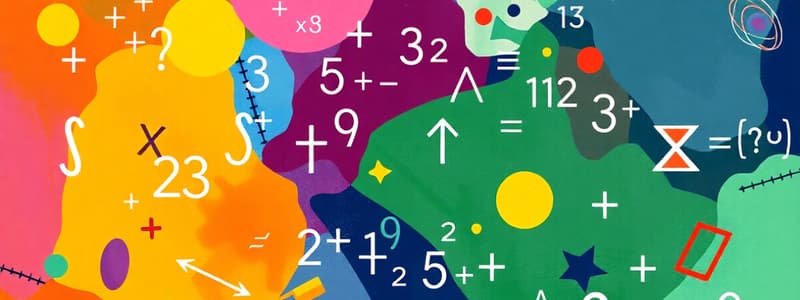Podcast
Questions and Answers
What is the first step in problem-solving according to effective strategies?
What is the first step in problem-solving according to effective strategies?
- Using mathematical notation
- Devising a plan (correct)
- Carrying out the plan
- Looking back
Which of the following represents a method to verify a mathematical solution?
Which of the following represents a method to verify a mathematical solution?
- Transforming notations
- Looking back (correct)
- Exploring historical context
- Applying different formulas
What are theorems and proofs primarily used for in mathematics?
What are theorems and proofs primarily used for in mathematics?
- Visualizing data with graphs
- Proving statements true with logical arguments (correct)
- Representing equations clearly
- Solving problems using trial and error
Which of the following is an example of a mathematical tool?
Which of the following is an example of a mathematical tool?
What is a crucial aspect of mathematical notation?
What is a crucial aspect of mathematical notation?
What does arithmetic primarily deal with?
What does arithmetic primarily deal with?
Which branch of mathematics studies the relationships between angles and sides of triangles?
Which branch of mathematics studies the relationships between angles and sides of triangles?
Which of the following is a type of function?
Which of the following is a type of function?
In which field is mathematics not commonly applied?
In which field is mathematics not commonly applied?
What is a fundamental aspect of solving mathematical problems?
What is a fundamental aspect of solving mathematical problems?
Which of the following are types of numbers?
Which of the following are types of numbers?
Which mathematical concept describes a collection of objects?
Which mathematical concept describes a collection of objects?
Which branch of mathematics focuses on change and motion?
Which branch of mathematics focuses on change and motion?
Flashcards
Arithmetic
Arithmetic
Basic math operations: addition, subtraction, multiplication, and division.
Algebra
Algebra
Maths using variables and equations to solve problems.
Geometry
Geometry
Study of shapes, size, and space.
Calculus
Calculus
Signup and view all the flashcards
Functions
Functions
Signup and view all the flashcards
Equations
Equations
Signup and view all the flashcards
Numbers
Numbers
Signup and view all the flashcards
Problem Solving
Problem Solving
Signup and view all the flashcards
Mathematical Plan
Mathematical Plan
Signup and view all the flashcards
Mathematical Formula
Mathematical Formula
Signup and view all the flashcards
Mathematical Graph
Mathematical Graph
Signup and view all the flashcards
Mathematical Theorem
Mathematical Theorem
Signup and view all the flashcards
Solving a Math Problem
Solving a Math Problem
Signup and view all the flashcards
Study Notes
Introduction to Mathematics
- Mathematics is a fundamental discipline encompassing abstract concepts, structures, quantities, and spatial relationships.
- It encompasses a broad range of topics, including arithmetic, algebra, geometry, calculus, and more.
- Mathematics plays a crucial role in various fields, including science, engineering, finance, and computer science.
- It provides tools for modeling and understanding the world around us.
Branches of Mathematics
- Arithmetic: The foundation of mathematics, dealing with basic operations like addition, subtraction, multiplication, and division on numbers.
- Algebra: Extends arithmetic by introducing variables and equations to represent unknown quantities and solve problems.
- Geometry: Focuses on shapes, sizes, and relationships in space. Sub-branches include Euclidean geometry, non-Euclidean geometry, and analytic geometry.
- Calculus: A branch of mathematics dealing with change and motion, encompassing differential calculus and integral calculus.
- Trigonometry: Studies relationships between angles and sides of triangles and their applications in various fields.
Core Mathematical Concepts
- Numbers: Different types of numbers, including natural numbers, integers, rational numbers, irrational numbers, and real numbers; understanding their properties and relationships.
- Sets: Collection of objects; different set operations include union, intersection, and complement; understanding set theory.
- Functions: Relationships between inputs and outputs; different function types (linear, quadratic, exponential).
- Equations and Inequalities: Representing relationships between quantities or expressions using equations and inequalities allowing us to estimate variables, and solving them to find solutions.
- Logic: Formal system of reasoning using statements and logical operators to test validity.
Applications of Mathematics
- Science: Mathematical models and equations are crucial in physics, chemistry, and biology.
- Engineering: Used in design, analysis, and construction of various structures and systems.
- Finance: Essential for financial modeling, risk assessment, and investment analysis.
- Computer Science: Crucial for programming, algorithm design, and data analysis.
Mathematical Problem-Solving Strategies
- Understanding the problem: Identifying the given information, what's unknown, and what relationships exist between them.
- Devising a plan: Choosing an appropriate strategy to solve the problem (e.g., using formulas, drawing diagrams, working backwards).
- Carrying out the plan: Implementing the chosen strategy, showing all steps and calculations.
- Looking back: Checking the solution, ensuring it makes sense and addresses the problem.
Important Mathematical Tools
- Formulas: Equations representing relationships between different quantities in specific contexts (e.g., area of a circle, Pythagorean theorem).
- Graphs: Visual representations of data, functions, and relationships.
- Theorems & Proofs: Statements that have been proven true, with logical arguments.
Mathematical Notation
- Mathematics uses specific symbols and notations to represent concepts and operations clearly.
History of Mathematics
- Mathematics has developed over millennia, evolving from basic counting systems to complex theories and applications.
- Different civilizations contributed significantly to the development of mathematical concepts
Studying That Suits You
Use AI to generate personalized quizzes and flashcards to suit your learning preferences.




